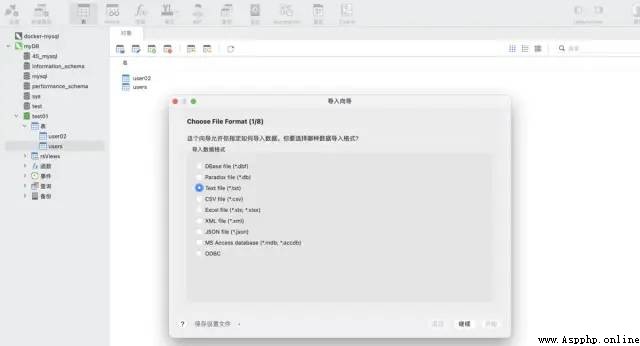This article mainly introduces “ How to use it? Python Read tens of millions of data and write it automatically MySQL database ”, In daily operation , I believe many people are using Python Read tens of millions of data and write it automatically MySQL There are doubts about the database , Xiao Bian consulted all kinds of materials , Sort out simple and easy-to-use operation methods , I hope to answer ” How to use it? Python Read tens of millions of data and write it automatically MySQL database ” Your doubts help ! Next , Please follow Xiaobian to learn !
Use navicat The Import Wizard function of the tool . Support multiple file formats , You can automatically create a table according to the file fields , You can also insert data into an existing table , It's very fast and convenient .


Test data :csv Format , about 1200 Line ten thousand
import pandas as pddata = pd.read_csv('./tianchi_mobile_recommend_train_user.csv')data.shapePrint the results :

Mode one :python pymysql library
install pymysql command :
pip install pymysql
Code implementation :
import pymysql# Database connection information conn = pymysql.connect( host='127.0.0.1', user='root', passwd='wangyuqing', db='test01', port = 3306, charset="utf8")# Block processing big_size = 100000# Block traversal writes to mysqlwith pd.read_csv('./tianchi_mobile_recommend_train_user.csv',chunksize=big_size) as reader: for df in reader: datas = [] print(' Handle :',len(df))# print(df) for i ,j in df.iterrows(): data = (j['user_id'],j['item_id'],j['behavior_type'], j['item_category'],j['time']) datas.append(data) _values = ",".join(['%s', ] * 5) sql = """insert into users(user_id,item_id,behavior_type ,item_category,time) values(%s)""" % _values cursor = conn.cursor() cursor.executemany(sql,datas) conn.commit() # Close the service conn.close()cursor.close()print(' Deposit successful !')
Mode two :pandas sqlalchemy:pandas Need to introduce sqlalchemy To support sql, stay sqlalchemy With the support of , It can realize the query of all common database types 、 Update and other operations .
Code implementation :
from sqlalchemy import create_engineengine = create_engine('mysql+pymysql://root:[email protected]:3306/test01')data = pd.read_csv('./tianchi_mobile_recommend_train_user.csv')data.to_sql('user02',engine,chunksize=100000,index=None)print(' Deposit successful !')pymysql The method takes 12 branch 47 second , It takes a long time , A lot of code , and pandas It takes only five lines of code to implement this requirement , It only took 4 About minutes . Finally add , Method 1 needs to create a table in advance , Mode 2 does not require . So I recommend you to use the second method , It is convenient and efficient . If you still feel that your speed is slow , Consider joining multiple processes 、 Multithreading .
The most complete three store data in MySQL Database method :
Direct deposit , utilize navicat Import Wizard function of
Python pymysql
Pandas sqlalchemy
Here we are , About “ How to use it? Python Read tens of millions of data and write it automatically MySQL database ” That's the end of my study , I hope we can solve your doubts . The combination of theory and practice can better help you learn , Let's try ! If you want to continue to learn more related knowledge , Please continue to pay attention to Yisu cloud website , Xiaobian will continue to strive to bring you more practical articles !